Samsung SGH-A927 User Manual

P O R T A B L E Q U A D - B A N D
M O B I L E P H O N E
U s e r M a n u a l
Please read this manual before operating your phone, and keep it for future reference.
Intellectual Property
All Intellectual Property, as defined below, owned by or which is otherwise the property of Samsung or its respective suppliers relating to the SAMSUNG Phone, including but not limited to, accessories, parts, or software relating there to (the “Phone System”), is proprietary to Samsung and protected under federal laws, state laws, and international treaty provisions. Intellectual Property includes, but is not limited to, inventions (patentable or unpatentable), patents, trade secrets, copyrights, software, computer programs, and related documentation and other works of authorship. You may not infringe or otherwise violate the rights secured by the Intellectual Property. Moreover, you agree that you will not (and will not attempt to) modify, prepare derivative works of, reverse engineer, decompile, disassemble, or otherwise attempt to create source code from the software. No title to or ownership in the Intellectual Property is transferred to you. All applicable rights of the Intellectual Property shall remain with SAMSUNG and its suppliers.
Samsung Telecommunications America (STA), LLC
Headquarters: |
Customer Care Center: |
1301 E. Lookout Drive |
1000 Klein Rd. |
Richardson, TX 75082 |
Plano, TX 75074 |
Toll Free Tel: |
1.888.987.HELP (4357) |
Internet Address: http://www.samsungusa.com
©
2010 Samsung Telecommunications America, LLC is a registered trademark of Samsung Electronics America, Inc. and its related entities.
a927_UCJF4_BH_070710_F7

Do you have questions about your Samsung Mobile Phone?
For 24 hour information and assistance, we offer a new FAQ/ARS System (Automated Response System) at:
www.samsungtelecom.com/support
T9 Text Input is licensed by Tegic Communications and is covered by U.S. Pat. 5,818,437; U.S. Pat. 5,953,541; U.S. Pat. 6,011,554 and other patents pending.
ACCESS® and NetFront™ are trademarks or registered trademarks of ACCESS Co., Ltd. in Japan and other countries.
The Bluetooth® word mark, figure mark (stylized “B Design”), and combination mark (Bluetooth word mark and “B Design”) are registered trademarks and are wholly owned by the Bluetooth SIG.
microSD™ and the microSD logo are Trademarks of the SD Card Association. Openwave® is a registered Trademark of Openwave, Inc.
 and
and  are trademarks of SRS Labs, Inc. CS Headphone and WOW HD technologies are incorporated under license from SRS Labs, Inc.
are trademarks of SRS Labs, Inc. CS Headphone and WOW HD technologies are incorporated under license from SRS Labs, Inc.
•SRS CS Headphone™ delivers a 5.1 surround sound experience over standard headphones or earbuds when listening to multichannel content, such as DVD movies.
•WOW HD™ significantly improves the playback quality of audio, delivering a dynamic 3D entertainment experience with deep, rich bass and high frequency clarity for crisp detail.
Devices purchased for use on AT&T's system are designed for use exclusively on AT&T's system. You agree that you won't make any modifications to the Equipment or programming to enable the Equipment to operate on any other system. A voice plan is required on all voice-capable devices, unless specifically noted otherwise in the terms governing your agreement. Some devices or plans may require you to subscribe to a data plan.
Your phone is designed to make it easy for you to access a wide variety of content. For your protection, AT&T wants you to be aware that some applications that you enable may involve the location of your phone being shared. For applications available through AT&T, AT&T
offers privacy controls that let you decide how an application may use the location of your phone and other phones on your account. However, AT&T's privacy tools do not apply to applications available outside of AT&T. Please review the terms and conditions and the associated privacy policy for each location-based service to learn how location information will be used and protected.
Your phone may be used to access the Internet and to download, and/or purchase goods, applications, and services from AT&T or elsewhere from third parties. AT&T provides tools for you to control access to the Internet and certain Internet content. These controls may not be available for certain devices which bypass AT&T controls.
AT&T may collect certain types of information from your device when you use AT&T services to provide customer support and to improve its services. For more information on AT&T's Privacy Policy, visit http://www.att.com/privacy.
Open Source Software
Some software components of this product incorporate source code covered under GNU General Public License (GPL), GNU Lesser General Public License (LGPL), OpenSSL License, BSD License and other open source licenses. To obtain the source code covered under the open source licenses, please visit:
http://opensource.samsung.com/category/mobile/mobile-phone/.
Disclaimer of Warranties; Exclusion of Liability
EXCEPT AS SET FORTH IN THE EXPRESS WARRANTY CONTAINED ON THE WARRANTY PAGE ENCLOSED WITH THE PRODUCT, THE PURCHASER TAKES THE PRODUCT “AS IS”, AND SAMSUNG MAKES NO EXPRESS OR IMPLIED WARRANTY OF ANY KIND WHATSOEVER WITH RESPECT TO THE PRODUCT, INCLUDING BUT NOT LIMITED TO THE MERCHANTABILITY OF THE PRODUCT OR ITS FITNESS FOR ANY PARTICULAR PURPOSE OR USE; THE DESIGN, CONDITION OR QUALITY OF THE PRODUCT; THE PERFORMANCE OF THE PRODUCT; THE WORKMANSHIP OF THE PRODUCT OR THE COMPONENTS CONTAINED THEREIN; OR COMPLIANCE OF THE PRODUCT WITH THE REQUIREMENTS OF ANY LAW, RULE, SPECIFICATION OR CONTRACT PERTAINING THERETO. NOTHING CONTAINED IN THE INSTRUCTION MANUAL SHALL BE CONSTRUED TO CREATE AN EXPRESS OR IMPLIED WARRANTY OF ANY KIND WHATSOEVER WITH RESPECT TO THE PRODUCT. IN ADDITION, SAMSUNG SHALL NOT BE LIABLE FOR ANY DAMAGES OF ANY KIND RESULTING FROM THE PURCHASE OR USE OF THE PRODUCT OR ARISING FROM THE BREACH OF THE EXPRESS WARRANTY, INCLUDING INCIDENTAL, SPECIAL OR CONSEQUENTIAL DAMAGES, OR LOSS OF ANTICIPATED PROFITS OR BENEFITS.

Table of Contents
Section 1: Getting Started .............................................. |
5 |
Setting Up Your Phone . . . . . . . . . . . . . . . . . . . . . . . . . . . . . . . 5 Charging a Battery . . . . . . . . . . . . . . . . . . . . . . . . . . . . . . . . . 7 Switching the Phone On or Off . . . . . . . . . . . . . . . . . . . . . . . . . 8 Locking the Touch Screen . . . . . . . . . . . . . . . . . . . . . . . . . . . . 9 Setting Up Your Voice Mail . . . . . . . . . . . . . . . . . . . . . . . . . . . . 9
Section 2: Understanding Your Phone ......................... |
10 |
Features of Your Phone . . . . . . . . . . . . . . . . . . . . . . . . . . . . . |
10 |
Front View of Your Phone . . . . . . . . . . . . . . . . . . . . . . . . . . . . |
10 |
Side Views of Your Phone . . . . . . . . . . . . . . . . . . . . . . . . . . . . |
12 |
Rear View of Your Phone . . . . . . . . . . . . . . . . . . . . . . . . . . . . |
13 |
Display Layout . . . . . . . . . . . . . . . . . . . . . . . . . . . . . . . . . . . . |
13 |
Using the Multitasking Menu . . . . . . . . . . . . . . . . . . . . . . . . . |
16 |
Section 3: Menu Navigation ......................................... |
18 |
Menu Navigation . . . . . . . . . . . . . . . . . . . . . . . . . . . . . . . . . . |
18 |
Widgets . . . . . . . . . . . . . . . . . . . . . . . . . . . . . . . . . . . . . . . . . |
24 |
Widget Bar Navigation . . . . . . . . . . . . . . . . . . . . . . . . . . . . . . |
29 |
Understanding the Events Widget . . . . . . . . . . . . . . . . . . . . . . |
31 |
Section 4: Call Functions ............................................. |
32 |
Displaying Your Phone Number . . . . . . . . . . . . . . . . . . . . . . . 32 Making a Call . . . . . . . . . . . . . . . . . . . . . . . . . . . . . . . . . . . . . 32 Making a Call from the Address Book . . . . . . . . . . . . . . . . . . . 34 Answering a Call . . . . . . . . . . . . . . . . . . . . . . . . . . . . . . . . . . 34 Dialing Options . . . . . . . . . . . . . . . . . . . . . . . . . . . . . . . . . . . . 35
Video Share . . . . . . . . . . . . . . . . . . . . . . . . . . . . . . . . . . . . . . 35
Recent Calls . . . . . . . . . . . . . . . . . . . . . . . . . . . . . . . . . . . . . 37
Call Time . . . . . . . . . . . . . . . . . . . . . . . . . . . . . . . . . . . . . . . . 40
Data Counter . . . . . . . . . . . . . . . . . . . . . . . . . . . . . . . . . . . . . 40
Options During a Call . . . . . . . . . . . . . . . . . . . . . . . . . . . . . . . 41
Section 5: Entering Text ............................................... |
45 |
Keys . . . . . . . . . . . . . . . . . . . . . . . . . . . . . . . . . . . . . . . . . . . 45
Using the QWERTY Keyboard . . . . . . . . . . . . . . . . . . . . . . . . . 46
Changing the Text Input Mode . . . . . . . . . . . . . . . . . . . . . . . . 47
Using T9 Mode . . . . . . . . . . . . . . . . . . . . . . . . . . . . . . . . . . . 48
Using Abc In Portrait Mode . . . . . . . . . . . . . . . . . . . . . . . . . . 50
Using Numeric In Portrait Mode . . . . . . . . . . . . . . . . . . . . . . . 50
Using Symbols . . . . . . . . . . . . . . . . . . . . . . . . . . . . . . . . . . . . 50
Section 6: Changing Your Settings .............................. |
51 |
Sound Profile . . . . . . . . . . . . . . . . . . . . . . . . . . . . . . . . . . . . . 51
Normal Profile . . . . . . . . . . . . . . . . . . . . . . . . . . . . . . . . . . . . 51
Silent Profile . . . . . . . . . . . . . . . . . . . . . . . . . . . . . . . . . . . . . 53
Driving Profile . . . . . . . . . . . . . . . . . . . . . . . . . . . . . . . . . . . . 54
Outdoor Profile . . . . . . . . . . . . . . . . . . . . . . . . . . . . . . . . . . . 56
Display and Light Settings . . . . . . . . . . . . . . . . . . . . . . . . . . . 58
Time and Date . . . . . . . . . . . . . . . . . . . . . . . . . . . . . . . . . . . . 60
Phone Settings . . . . . . . . . . . . . . . . . . . . . . . . . . . . . . . . . . . 61
Call Settings . . . . . . . . . . . . . . . . . . . . . . . . . . . . . . . . . . . . . 66
Connectivity . . . . . . . . . . . . . . . . . . . . . . . . . . . . . . . . . . . . . . 68
1
Bluetooth Secure Mode . . . . . . . . . . . . . . . . . . . . . . . . . . . . . . 69
Configuring Your Phone’s USB Settings . . . . . . . . . . . . . . . . . . 70
Network Profile Configuration . . . . . . . . . . . . . . . . . . . . . . . . . 71
Applications Settings . . . . . . . . . . . . . . . . . . . . . . . . . . . . . . . 72
Memory Management . . . . . . . . . . . . . . . . . . . . . . . . . . . . . . . 74
Software Update . . . . . . . . . . . . . . . . . . . . . . . . . . . . . . . . . . . 76
Phone Information . . . . . . . . . . . . . . . . . . . . . . . . . . . . . . . . . 76
Section 7: Mobile Video ................................................ |
77 |
Viewing a Video Clip . . . . . . . . . . . . . . . . . . . . . . . . . . . . . . . . |
77 |
Using the Video Categories . . . . . . . . . . . . . . . . . . . . . . . . . . . |
77 |
Customizing Mobile Video . . . . . . . . . . . . . . . . . . . . . . . . . . . . |
78 |
Section 8: Understanding Your Address Book ............ |
80 |
Address Book Settings . . . . . . . . . . . . . . . . . . . . . . . . . . . . . . 80
Adding a New Contact . . . . . . . . . . . . . . . . . . . . . . . . . . . . . . 80
Using Contacts . . . . . . . . . . . . . . . . . . . . . . . . . . . . . . . . . . . . 84
Address Book Entry Options . . . . . . . . . . . . . . . . . . . . . . . . . . 85
Finding My Own Phone Number . . . . . . . . . . . . . . . . . . . . . . . 86
FDN Mode . . . . . . . . . . . . . . . . . . . . . . . . . . . . . . . . . . . . . . . 86
Group Settings . . . . . . . . . . . . . . . . . . . . . . . . . . . . . . . . . . . . 87
Address Book Favorites . . . . . . . . . . . . . . . . . . . . . . . . . . . . . 88
Managing Address Book Entries . . . . . . . . . . . . . . . . . . . . . . . 88
Section 9: Camera ........................................................ |
92 |
Using the Camera . . . . . . . . . . . . . . . . . . . . . . . . . . . . . . . . . . 92
Camera and Camcorder Options . . . . . . . . . . . . . . . . . . . . . . . 93
Using the Camcorder . . . . . . . . . . . . . . . . . . . . . . . . . . . . . . . 99
Section 10: My Stuff ................................................... |
102 |
My Stuff Functions . . . . . . . . . . . . . . . . . . . . . . . . . . . . . . . . 102
Applications . . . . . . . . . . . . . . . . . . . . . . . . . . . . . . . . . . . . . 103
Audio . . . . . . . . . . . . . . . . . . . . . . . . . . . . . . . . . . . . . . . . . . 103
Games . . . . . . . . . . . . . . . . . . . . . . . . . . . . . . . . . . . . . . . . . 105
Pictures . . . . . . . . . . . . . . . . . . . . . . . . . . . . . . . . . . . . . . . . 105
Tools . . . . . . . . . . . . . . . . . . . . . . . . . . . . . . . . . . . . . . . . . . 107
Video . . . . . . . . . . . . . . . . . . . . . . . . . . . . . . . . . . . . . . . . . . 107
Other Files . . . . . . . . . . . . . . . . . . . . . . . . . . . . . . . . . . . . . . 107
Used Space . . . . . . . . . . . . . . . . . . . . . . . . . . . . . . . . . . . . . 107
Section 11: Messaging ............................................... |
108 |
Types of Messages . . . . . . . . . . . . . . . . . . . . . . . . . . . . . . . 108 Creating and Sending Messages . . . . . . . . . . . . . . . . . . . . . 108 Additional Message Options . . . . . . . . . . . . . . . . . . . . . . . . . 109 Viewing New Received Messages . . . . . . . . . . . . . . . . . . . . . 111 Using Message Options . . . . . . . . . . . . . . . . . . . . . . . . . . . . 111 Using Mobile Email . . . . . . . . . . . . . . . . . . . . . . . . . . . . . . . . 112 Using Instant Messaging (IM) . . . . . . . . . . . . . . . . . . . . . . . . 113 Deleting Messages . . . . . . . . . . . . . . . . . . . . . . . . . . . . . . . . 114 Messaging Settings . . . . . . . . . . . . . . . . . . . . . . . . . . . . . . . 114 Templates . . . . . . . . . . . . . . . . . . . . . . . . . . . . . . . . . . . . . . 117 Delete by Folder . . . . . . . . . . . . . . . . . . . . . . . . . . . . . . . . . . 119 Used Space . . . . . . . . . . . . . . . . . . . . . . . . . . . . . . . . . . . . . 119
Section 12: Games and Applications ......................... |
120 |
Games . . . . . . . . . . . . . . . . . . . . . . . . . . . . . . . . . . . . . . . . . 120
Applications . . . . . . . . . . . . . . . . . . . . . . . . . . . . . . . . . . . . . 120
2
Section 13: AppCenter ................................................ |
123 |
Downloading Multimedia Files . . . . . . . . . . . . . . . . . . . . . . . 123
Ringtones . . . . . . . . . . . . . . . . . . . . . . . . . . . . . . . . . . . . . . 123
Games . . . . . . . . . . . . . . . . . . . . . . . . . . . . . . . . . . . . . . . . . 124
Cool Tools/Apps . . . . . . . . . . . . . . . . . . . . . . . . . . . . . . . . . . 124
Videos . . . . . . . . . . . . . . . . . . . . . . . . . . . . . . . . . . . . . . . . . 124
Color Graphics . . . . . . . . . . . . . . . . . . . . . . . . . . . . . . . . . . . 124
Fun Packs . . . . . . . . . . . . . . . . . . . . . . . . . . . . . . . . . . . . . . 124
Answer Tones . . . . . . . . . . . . . . . . . . . . . . . . . . . . . . . . . . . 124
Multimedia Store . . . . . . . . . . . . . . . . . . . . . . . . . . . . . . . . . 125
AppCenter Options . . . . . . . . . . . . . . . . . . . . . . . . . . . . . . . . 125
Section 14: Music ....................................................... |
126 |
Accessing AT&T Music . . . . . . . . . . . . . . . . . . . . . . . . . . . . . 126 Adding Music to Your Handset . . . . . . . . . . . . . . . . . . . . . . . 128 Shop Music . . . . . . . . . . . . . . . . . . . . . . . . . . . . . . . . . . . . . 128 Using Playlists . . . . . . . . . . . . . . . . . . . . . . . . . . . . . . . . . . . 130 MusicID 2 . . . . . . . . . . . . . . . . . . . . . . . . . . . . . . . . . . . . . . 135 AT&T Radio . . . . . . . . . . . . . . . . . . . . . . . . . . . . . . . . . . . . . 135 Music Videos . . . . . . . . . . . . . . . . . . . . . . . . . . . . . . . . . . . . 136
Section 15: AT&T GPS ................................................ |
138 |
Launching AT&T Navigator . . . . . . . . . . . . . . . . . . . . . . . . . . 138 Using Navigator . . . . . . . . . . . . . . . . . . . . . . . . . . . . . . . . . . 139 Obtaining Driving Directions . . . . . . . . . . . . . . . . . . . . . . . . . 139 Shopping for GPS Applications . . . . . . . . . . . . . . . . . . . . . . . 140 Where . . . . . . . . . . . . . . . . . . . . . . . . . . . . . . . . . . . . . . . . . 140
Section 16: Tools ........................................................ |
142 |
Tools . . . . . . . . . . . . . . . . . . . . . . . . . . . . . . . . . . . . . . . . . . 142
Camera . . . . . . . . . . . . . . . . . . . . . . . . . . . . . . . . . . . . . . . . 142
Music Player . . . . . . . . . . . . . . . . . . . . . . . . . . . . . . . . . . . . 142
Voice Recognition . . . . . . . . . . . . . . . . . . . . . . . . . . . . . . . . 144
Record Audio . . . . . . . . . . . . . . . . . . . . . . . . . . . . . . . . . . . . 145
Alarms . . . . . . . . . . . . . . . . . . . . . . . . . . . . . . . . . . . . . . . . . 146
Calendar . . . . . . . . . . . . . . . . . . . . . . . . . . . . . . . . . . . . . . . 147
Recent Calls . . . . . . . . . . . . . . . . . . . . . . . . . . . . . . . . . . . . 149
Memo . . . . . . . . . . . . . . . . . . . . . . . . . . . . . . . . . . . . . . . . . 149
Tasks . . . . . . . . . . . . . . . . . . . . . . . . . . . . . . . . . . . . . . . . . 150
Calculator . . . . . . . . . . . . . . . . . . . . . . . . . . . . . . . . . . . . . . 150
Tip Calculator . . . . . . . . . . . . . . . . . . . . . . . . . . . . . . . . . . . 150
Converter . . . . . . . . . . . . . . . . . . . . . . . . . . . . . . . . . . . . . . 151
World Clock . . . . . . . . . . . . . . . . . . . . . . . . . . . . . . . . . . . . . 152
Timer . . . . . . . . . . . . . . . . . . . . . . . . . . . . . . . . . . . . . . . . . 152
Stopwatch . . . . . . . . . . . . . . . . . . . . . . . . . . . . . . . . . . . . . . 153
Section 17: Mobile Web ............................................. |
154 |
Accessing the Mobile Web . . . . . . . . . . . . . . . . . . . . . . . . . . 154 Homepage - att.net . . . . . . . . . . . . . . . . . . . . . . . . . . . . . . . 154 Navigating with the Mobile Web . . . . . . . . . . . . . . . . . . . . . . 155 Enter a URL . . . . . . . . . . . . . . . . . . . . . . . . . . . . . . . . . . . . . 156 Search the Internet . . . . . . . . . . . . . . . . . . . . . . . . . . . . . . . 156 My Shortcuts . . . . . . . . . . . . . . . . . . . . . . . . . . . . . . . . . . . . 156 My Account . . . . . . . . . . . . . . . . . . . . . . . . . . . . . . . . . . . . . 156 Using Bookmarks . . . . . . . . . . . . . . . . . . . . . . . . . . . . . . . . 157 Emptying the Cookies . . . . . . . . . . . . . . . . . . . . . . . . . . . . . 158
3
Using Your History . . . . . . . . . . . . . . . . . . . . . . . . . . . . . . . . 158
Changing the WAP Profiles . . . . . . . . . . . . . . . . . . . . . . . . . . 158
Section 18: Accessibility ............................................ |
160 |
Section 19: Health and Safety Information ............... |
161 |
Health and Safety Information . . . . . . . . . . . . . . . . . . . . . . . . |
161 |
Please Note the Following Information When Using |
|
Your Handset . . . . . . . . . . . . . . . . . . . . . . . . . . . . . . . . . . |
162 |
Samsung Mobile Products and Recycling . . . . . . . . . . . . . . . |
163 |
UL Certified Travel Adapter . . . . . . . . . . . . . . . . . . . . . . . . . . |
163 |
Consumer Information on Wireless Phones . . . . . . . . . . . . . . |
163 |
Road Safety . . . . . . . . . . . . . . . . . . . . . . . . . . . . . . . . . . . . . |
169 |
Responsible Listening . . . . . . . . . . . . . . . . . . . . . . . . . . . . . . |
171 |
Operating Environment . . . . . . . . . . . . . . . . . . . . . . . . . . . . . |
173 |
Using Your Phone Near Other Electronic Devices . . . . . . . . . |
173 |
Potentially Explosive Environments . . . . . . . . . . . . . . . . . . . . |
174 |
Emergency Calls . . . . . . . . . . . . . . . . . . . . . . . . . . . . . . . . . . |
174 |
FCC Notice and Cautions . . . . . . . . . . . . . . . . . . . . . . . . . . . |
175 |
Other Important Safety Information . . . . . . . . . . . . . . . . . . . . |
175 |
Product Performance . . . . . . . . . . . . . . . . . . . . . . . . . . . . . . |
176 |
Availability of Various Features/Ring Tones . . . . . . . . . . . . . . |
177 |
Battery Standby and Talk Time . . . . . . . . . . . . . . . . . . . . . . . |
177 |
Battery Precautions . . . . . . . . . . . . . . . . . . . . . . . . . . . . . . . |
177 |
Care and Maintenance . . . . . . . . . . . . . . . . . . . . . . . . . . . . . |
179 |
Section 20: Warranty Information ............................. |
180 |
Standard Limited Warranty . . . . . . . . . . . . . . . . . . . . . . . . . . 180 End User License Agreement for Software . . . . . . . . . . . . . . 183
Index ............................................................................ |
188 |
4
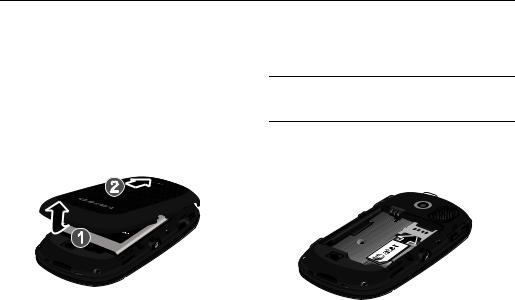
Section 1: Getting Started
This section explains how to start using your phone by first configuring your hardware, activating your service, and then setting up your voice mail.
Setting Up Your Phone
Prior to use, it is necessary to install both the battery and SIM into their corresponding internal compartments. The microSD card slot is also located in this same internal area.
1.Remove the battery cover by placing your thumbnail into the slot at the bottom of the phone (1). If you have fragile nails, use a pointed object.
2.Lift the cover up and off the phone (2).
Installing the SIM Card
When you subscribe to a cellular network, you are provided with a plug-in SIM card loaded with your subscription details, such as your PIN, available optional services, and many others features.
Important!: The plug-in SIM card information and its contacts can be easily damaged by scratching or bending, so be careful when handling, inserting, or removing the card. Keep all SIM cards out of reach of small children.
Carefully slide the SIM card into the SIM card socket (as shown below) until the card locks into place.
•Make sure that the card’s gold contacts face into the phone and that the angled corner of the card is positioned as shown.
|
|
|
|
|
|
|
|
Getting Started |
5 |
|
|
|
|
|
|
|
|
||
|
|
|
|
|
|
|
|
||
|
|
|
|
|
|
|
|
||
|
|
|
|
|
|
|
|

Note: If the card is not inserted correctly, the phone does not detect the SIM card. Re-orient the card back into the slot if the SIM is not detected.
Installing the Memory Card
Your phone also supports the use of a memory card (microSD™) for storage of such things as data, music, pictures, and video files. This type of memory card is designed for use with this mobile phone and other devices.
1.Push the microSD card into the slot until it clicks (as shown).
•Make sure the microSD’s gold contact pins face downward and the card is securely inserted.
Incorrect
Correct
Note: Your phone has been tested to support up to a 16GB memory card.
Installing the Battery
1.Insert the battery into the opening on the back of the phone, making sure the connectors align (1).
2.Gently press down to secure the battery (2).
Note: Make sure the battery is properly installed before switching on the phone.
6
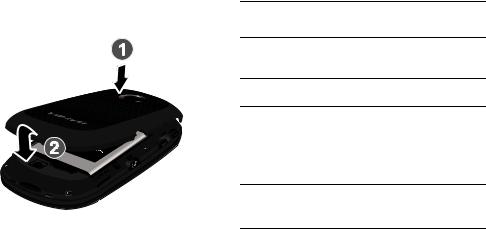
Replacing the Battery Cover
1.Place the battery cover onto the back of the phone and press down (1).
2.Press down on the bottom of the phone (2) until you hear a light click.
Charging a Battery
Your phone is powered by a rechargeable Li-ion battery. The Travel Adapter that is used to charge the battery, is included with your phone. Use only Samsung-approved batteries and chargers.
Note: Long backlight settings, searching for service, vibrate mode, browser use, and other variables may reduce the battery’s talk and standby times.
Although you can use the phone while the battery is charging, doing so requires additional charging time.
Note: You must fully charge the battery before using your phone for the first time. A discharged battery recharges fully in approximately 4 hours.
Using the Travel Adapter
1.With the battery installed, lift and rotate the plastic Power/ Accessory Interface connector cover at the top right side of phone.
Important!: Verify that the handset battery is installed prior to connection. If the battery is not properly installed and the wall charger is connected, the handset may power off and on continuously, preventing proper operation.
Getting Started |
7 |
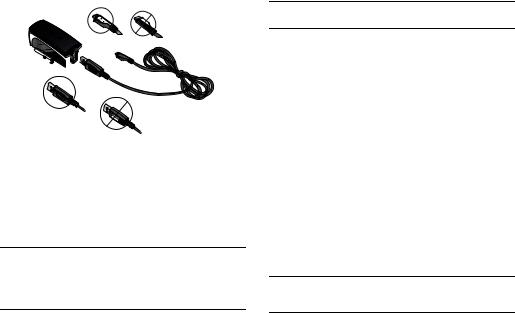
Correct
Incorrect
Correct
Incorrect
2.Plug the data cable into the base piece provided and into the Power/Accessory Interface connector on your phone.
3.Plug the base piece into a standard AC wall outlet.
4.When the battery is fully charged, the phone displays a message telling you the battery is full. Remove the connector from the phone.
Warning!: If your handset has a touch screen display, please note that a touch screen responds best to a light touch from the pad of your finger or a non-metallic stylus. Using excessive force or a metallic object when pressing on the touch screen may damage the tempered glass surface and void the warranty. For more information, refer to “Standard Limited Warranty” on page 180.
Note: Failure to unplug the wall charger before you remove the battery can cause damage to the phone.
Low Battery Indicator
When the battery is weak and only a few minutes of talk time remain, the battery icon ( ) blinks and the device sounds a warning tone at regular intervals. In this condition, your phone conserves its remaining battery power, not by turning off the backlight, but by entering the dimming mode. For a quick check of your battery level, glance at the battery charge indicator located in the upper-right corner of your device’s display. Five bars (
) blinks and the device sounds a warning tone at regular intervals. In this condition, your phone conserves its remaining battery power, not by turning off the backlight, but by entering the dimming mode. For a quick check of your battery level, glance at the battery charge indicator located in the upper-right corner of your device’s display. Five bars (  ) indicate a full charge.
) indicate a full charge.
When the battery level becomes too low, the phone automatically turns off.
Switching the Phone On or Off
1.Press and hold  or
or  until the phone switches on. The phone launches the activation splash screen and then proceeds to search for the network. Once the network has been found, you can make or receive calls.
until the phone switches on. The phone launches the activation splash screen and then proceeds to search for the network. Once the network has been found, you can make or receive calls.
Note: The display language is preset to English at the factory. To change the language, use the Language menu. For more information, refer to
“Changing Your Settings” on page 51.
8

2. |
Press and hold |
, until the phone switches off. |
|
|
Accessing Your Voice Mail |
|
|
|
|
|
||||
Locking the Touch Screen |
|
|
1. |
In Idle mode, press |
|
, then touch and hold |
|
|
|
. |
||||
|
|
|
|
|
|
|||||||||
1. |
Press and hold |
on the upper right side of the phone |
2. |
When connected, follow the voice prompts from the voice |
||||||||||
|
to lock the touch screen. |
|
|
|
mail center. |
|
|
|
|
|
||||
2. |
Press and hold |
again or touch and hold |
on the |
Accessing Your Voice Mail From Another Phone |
|
|||||||||
|
Idle screen to unlock the touch screen. |
|
|
1. |
Dial your wireless phone number. |
|
||||||||
Setting Up Your Voice Mail |
|
|
|
|
|
|
|
|||||||
|
|
2. |
When you hear your voicemail greeting, press |
|
|
(the |
||||||||
|
|
|
|
|||||||||||
1. |
In Idle mode, press |
|
, then touch and hold |
|
|
. |
|
asterisk key on the phone you are using). |
|
|
||||
|
|
|
|
|
||||||||||
|
You may be prompted to enter a password. |
|
|
3. |
Enter your passcode using the on-screen keypad. |
|
||||||||
Note: You can also access your voicemail from the on-screen keypad by touching 


 then pressing
then pressing  or touch Call.
or touch Call.
2.Follow the tutorial to create a password, record a greeting, and record your name.
Note: These steps may be different depending on your network.
Getting Started |
9 |
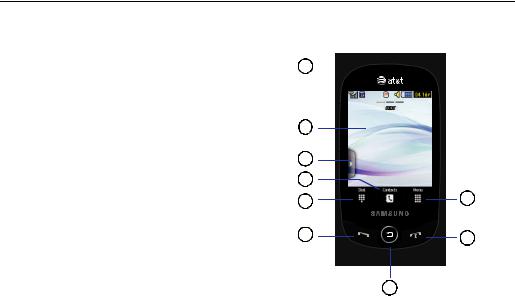
Section 2: Understanding Your Phone
This section outlines some key features of your phone. It also |
Front View of Your Phone |
||
displays the screen and the icons that appear when the phone is |
|
|
|
in use. |
|
|
|
Features of Your Phone |
|
|
|
Your phone is lightweight and easy to use, and it offers many useful features. The following list outlines a few of the features included in your phone.
•Touch screen provides quick response to a variety of in-phone menus and options including a Widget Bar and three main menus
•User friendly, menu driven access to features and options
• Ready access to the Internet with multi-window feature
• Built-in Bluetooth technology
• Instant Messaging (IM) capability
• AT&T GPS Navigation functionality provides real-time navigation
• microSD card compatibility for use in data storage and access
• HSDPA 7.2 mbps high speed download capability
• Other features include AT&T Music, Mobile Email, Voice Recognition, Files, Games, Alarms, Calendar, Memo, Tasks, Calculator, Tip Calculator, Unit Converter, World Clock, Timer, and Stopwatch.
10
1.External speaker: allows you to hear the caller.
2.Display: shows the information needed to operate your phone, such as the received signal strength, phone battery level, time, and so on.
3.Widget tab: allows you to open the Widget toolbar.
4.Contacts key: allows you to access your current Contacts, Groups, and Favorites lists.
5.Dial key: allows you to access the Phone Functions menu, such as Dialer and Contacts.
6.Talk/Send key: allows you to power on the phone, make or answer a call, and access your call history, Call Manager, and Block Caller features. Press and hold to redial the last phone number.
7.Back key: allows you to return to the previous menu. This key also allows you to return to the previous page within the Web browser.
8.Power/End key: ends a call. Press and hold to turn the phone on or off. While in a menu, pressing this key once cancels the current input and twice returns the phone to Idle mode.
9.Menu key: allows you to access your phone’s menu functions menu, such as Address Book, Messaging, AT&T Family Map, Mobile Video, AT&T Music, Games, Applications, Mobile Web, AppCenter, YPMobile, My stuff, Tools, Settings, and so on.
While in the Menu screen, the Menu key is replaced with the Message key. The Message key allows you to create new text or multimedia messages.
Understanding Your Phone |
11 |
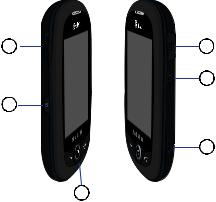
Side Views of Your Phone
1.Volume key: ( 
 ) allows you to adjust the ringer volume while in standby mode or adjust the voice volume during a call. When receiving an incoming call, briefly press down either end of the volume key to mute the ring tone. Press and hold either end of the volume key to reject the call and send it directly to voicemail. Adjusts text size
) allows you to adjust the ringer volume while in standby mode or adjust the voice volume during a call. When receiving an incoming call, briefly press down either end of the volume key to mute the ring tone. Press and hold either end of the volume key to reject the call and send it directly to voicemail. Adjusts text size
when reading a message or using the browser in the Applications folder.
2.Multitask key: (  ) launches the multitask menu. This menu provides easy access to some of the most commonly
) launches the multitask menu. This menu provides easy access to some of the most commonly
used features such as: Call, Messaging, Mobile Web, Music Player, and Games. You can also End all running programs/apps.
3.Microphone: allows other callers to hear you when you are speaking to them.
4.Camera/Camcorder key: (  ) allows you to take pictures or videos when you are in camera or camcorder mode. In Idle mode, press to launch the camera/ camcorder.
) allows you to take pictures or videos when you are in camera or camcorder mode. In Idle mode, press to launch the camera/ camcorder.
5.Lock key: (  ) lets you lock or unlock the touch screen. For more information on locking your phone, see “Locking and Unlocking the Phone” on page 18.
) lets you lock or unlock the touch screen. For more information on locking your phone, see “Locking and Unlocking the Phone” on page 18.
6.Power/Accessory Interface connector: (  ) allows you to connect a Travel Charger or other optional
) allows you to connect a Travel Charger or other optional
accessories such as a USB/data cable or a hands-free headset for convenient, hands-free conversations.
12
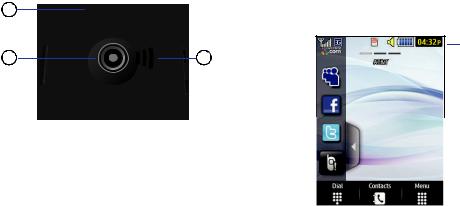
Rear View of Your Phone
1.3.5mm Headset jack: allows you to plug in headphones.
2.Camera lens: is used to take pictures and shoot videos.
3.External speaker: allows you to hear when the Speakerphone is turned on.
Display Layout
Your display screen provides a wealth of information about the phone’s status and options, as well as providing access to the Widget Bar. The display has four main areas:
Indicators
Widget |
|
|
|
|
|
|
Main |
|
Bar |
|
|
|
|
|
Display |
||
|
|
|
|
|
|
|
|
Area |
Function |
|
|
|
|
|
|
||
Categories |
|
|
|
|
|
|
|
|
|
|
|
|
|
|
|
|
|
Understanding Your Phone |
13 |

Widget Bar
The Widget Bar provides quick access to the functions you use most frequently (Analog clock, Digital clock, Dual clock, AT&T Social Net, Create message, Buddy list, Voice recognition, AT&T Navigator, AppCenter, Mobile Web, Today, Calendar, Favorite URL, Picture, Games, Widget memo1, 2, and 3, Message inbox, Record Audio, Memo, Timer, Go on a diet, Birthday, Sound Profile, Bluetooth, Calculator, Video, Yahoo Search, MSNBC, MySpace, Facebook, and Twitter. For more information about the Widget Bar, see “Widget Bar Navigation” on page 29.
Function Categories
Function categories are shortcuts to Dial for dialing a number, Contacts for accessing the contacts list, and Menu for displaying the icons for application and folder access. While viewing the Main Menus, the Menu category changes to Messaging, which can be used to view and create messages.
Icons
This list identifies the symbols that appear on your phone’s display and Indicator area:
Displays your current signal strength. The greater the number of bars, the stronger the signal.
Indicates that the Airplane Mode is active. You cannot send or receive any calls or access online information.
Displays when you are out of your service area.
Displays when a call is in progress.
Displays within the lock screen when a call has been missed.
Displays your battery’s charge level. The more bars you see, the more power you have remaining.
Displays when your connection to an EDGE network is active.
Displays when your phone is communicating with the EDGE network.
Displays when your connection to a 3G network is active.
Displays when your phone is communicating with the 3G network.
14

Displays when an internal microSD memory card is detected.
Displays when the phone is connected to a computer with a supported USB cable connection.
Displays within the Indicators area when a new text message is received.
Displays within the Indicators area when a new multimedia message is received.
Displays within the Indicators area when a new voice mail is received.
Displays within the Indicators area when a new WAP message is received.
Displays when Inbox is full - Text Message.
Displays when you set an alarm to ring at a specified time. For more information, refer to “Alarms” on page 146.
Displays when Call forwarding is set to Forward always. For more information, refer to “Call Settings” on page 66.
Displays when the Sound profile is set to Normal.
Displays when Silent Mode is activated
Displays when the Sound profile is set to Driving.
Displays when the Sound profile is set to Outdoor.
Displays when Bluetooth is activated.
Displays when a Bluetooth stereo headset has been paired with the phone.
Displays when a TTY device has been inserted.
Displays when signed on to AIM IM service.
Understanding Your Phone |
15 |

Displays when signed on to Windows Live IM service.
Displays when signed on to Yahoo IM service.
Displays when your Address Book is synchronizing with the AT&T Address Book, the network backup service.
For more details on configuring your phone’s settings, see
“Changing Your Settings” on page 51.
Using the Multitasking Menu
The Multitask key (  ) launches the Multitask menu that can be activated from within any active window or page on the phone. There is no need to stop what you are doing, if you want to quickly activate another common feature.
) launches the Multitask menu that can be activated from within any active window or page on the phone. There is no need to stop what you are doing, if you want to quickly activate another common feature.
The idea is to allow you to temporarily exit from your current location to access a group of common functions such as: Call, Messaging, Mobile Web, Music Player, Games, and End all. Using this key keeps you from having to completely exit from your current task or window, whether that be a text message, a web page, or an active call, just to quickly do something else.
Here is an example:
You might be in the middle of typing up an email or text message, when you suddenly realize that you need to make a quick call. Typically, you would have to exit from your current message, navigate to the Idle screen, make your call, after which you would have to go back and re-create your message.
Using this same situation, all you would have to do is:
1.Press  until the you see the Multitask menu screen.
until the you see the Multitask menu screen.
2.Touch Call, then enter your number and continue the call.
3.Once you are done, hang up the call normally and you are returned to the previous message screen.
Multitask Functions
Pressing the Multitasking key (  ) on the left side of the handset, allows you to choose from one of the following functions:
) on the left side of the handset, allows you to choose from one of the following functions:
16

•Call: allows you to make a voice call while using the handset for other tasks. If Music Player is active, it is muted during the call.
•Messaging: allows you to send a text or multimedia message while using the handset for other tasks.
•Mobile Web: allows you to launch the Mobile Web browser while using the handset for other tasks.
•Music player: allows you to launch the Music player while using the handset for other tasks. If an incoming call is received or you want to make a call, the Music player is muted.
•Games: allows you to quickly access Games while using the handset for other tasks.
•End all?: closes all running applications or tasks and returns you to the Idle screen.
When any Java application, such as a game, is paused, suspended, or minimized, the Multitask screen is modified to include the Java application. In the example below, the bowling game has been paused.
Touch the Up or Down arrows to scroll up or down.
Understanding Your Phone |
17 |
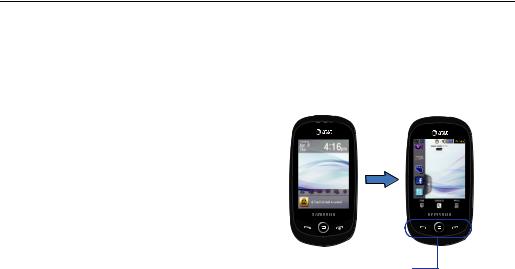
Section 3: Menu Navigation
This section explains the menu navigation for your phone. Your phone has done away with the need for navigation wheels or keypads. Your phone is completely navigable by either an on-screen touch or scroll.
•Touching an on-screen option activates the feature.
•Long menu lists can be easily viewed by using your fingertip to scroll up or down the on-screen list or by pressing the volume key up or down.
Menu Navigation
You can tailor the phone’s range of functions to fit your needs using both menus and widgets. Menus, sub-menus, and features can be accessed by scrolling through the available on-screen menus. Your phone originally has three main menus, but you can add seven more main menus for a total of ten.
Locking and Unlocking the Phone
When your phone is locked, there are two ways to unlock your phone:
•Press the lock button  located on the upper right side of your phone.
located on the upper right side of your phone.
•Touch and hold  on the Idle screen.
on the Idle screen.
The Idle Screen
The Idle screen provides access to many useful phone features, including popup Widgets and function categories (Dial, Contacts, and Menu).
Idle screen |
Lock key |
|||
|
|
|
|
|
|
|
|
|
|
Command Keys
18

Navigating Through the Main Menus
Your phone originally has three main menus, but you can add seven more main menus for a total of ten. Some icons can be deleted and replaced with new icons.
1.From the Idle screen, touch 

 . Main Menu 1 is displayed.
. Main Menu 1 is displayed.
2.Drag your finger across the Main Menus to scroll through the three Main Menus. You can scroll in either direction.
The icons initially contained in the three Main Menus are shown below.
Adding Additional Main Menus
To add another Main Menu, follow these steps:
1.Touch the Menu Edit icon ( ) located at the top right of any of the Main Menus.
) located at the top right of any of the Main Menus.
2.Scroll horizontally to Main Menu 4.
3.Touch the  icon.
icon.
Menu Navigation |
19 |
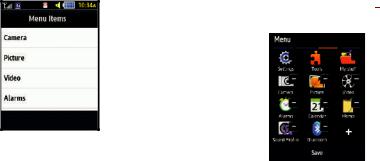
The Menu Items screen is displayed.
4.Touch one of the Menu Items to have the icon for that feature or application added to your menu. Default items that already have icons on a menu will be grayed out.
5.Continue to add Icons that you want on a main menu. When Main Menu 4 is full, you can scroll to Main Menu 5 and add icons to it also.
6.Touch Save to apply your menu updates or press  to cancel without saving.
to cancel without saving.
Removing an Icon from a Main Menu
1.Touch the Menu Edit icon (  ) located at the top right of any of the Main Menus.
) located at the top right of any of the Main Menus.
2.Scroll to the icon that you would like to remove. Icons that
display the  symbol cannot be removed. Only icons with the
symbol cannot be removed. Only icons with the  symbol next to them may be removed.
symbol next to them may be removed.
3.Touch the  symbol next to the icon you want removed. The icon is removed and the remaining icons shift to the
symbol next to the icon you want removed. The icon is removed and the remaining icons shift to the
left to fill the open spot on the menu.
4.Touch Save to apply your menu updates or press  to cancel without saving.
to cancel without saving.
20

Moving an Icon Within a Menu Screen
1.Touch the Menu Edit icon (  ) located at the top right of any of the Main Menus.
) located at the top right of any of the Main Menus.
2.Touch and drag any icon on the menu to the desired position on the menu.
3.Touch Save to apply your menu updates or press  to cancel without saving.
to cancel without saving.
Moving an Icon to a New Menu Screen
1.Touch the Menu Edit icon ( ) located at the top right of any of the Main Menus.
) located at the top right of any of the Main Menus.
2.Touch and drag any icon on the menu to the left or right edge of the menu and hold until the icon is moved to the previous or next menu. The moved icon is place at the end of the previous or next menu. Any displaced icons are moved to the first position of the next menu.
3.Touch Save to apply your menu updates or press  to cancel without saving.
to cancel without saving.
Opening an Application
Tap the associated on-screen icon.
•Press  to exit from the current menu and return to the previous screen.
to exit from the current menu and return to the previous screen.
•Press  to exit from the current location or function, cancel your input, and return to the Idle screen.
to exit from the current location or function, cancel your input, and return to the Idle screen.
Navigating Through Menus
As you navigate through a menu, options display on the screen as scrollable lists. Function categories, located at the bottom of most screens, provide access to additional screen options.
To navigate a scrollable list:
1.From the Idle screen, touch 

 .
.
2.Scroll through the main menus to find the desired option. Gently press the on-screen option.
3.From the available list of options you can either:
•Touch an on-screen entry to activate it.
•Firmly press and slide your finger up or down the screen to scroll through lists of menu items.
•Navigate through a long list by pressing the volume key up or down.
Note: Tapping or touching an individual entry on the list opens the list entry.
Menu Navigation |
21 |

Note: Scrolling requires that you press firmly on the screen then drag. When scrolling through a list make sure not to touch or press individual entries on the list because that opens the list entry.
22
Using the Power Search Tab
Within the Contacts list (sorted alphabetically) the Power Search tab allows to quickly “thumb through” the alphabetical listing of entries by first letter (A B C, ... Z). The Power Search tab is located along the right side of the screen and Contacts entries are then selected by pressing their name fields. The Power Search tab can also be used with your Music Player.
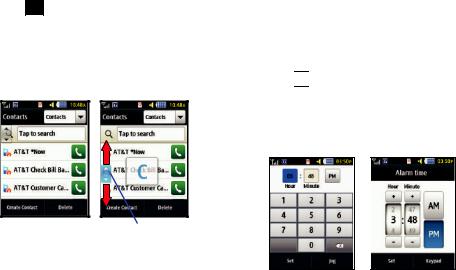
Contacts
1.Touch  .
.
2.Press and drag the Power Search tab until the first letter of the name of the contact you want to find is shown on the screen.
3.Release the Power Search tab and scroll to the desired contact.
Power Search tab
Scrolling Through Field Entries
Some screens ask you to assign a value to an on-screen field by either touching the up or down selection arrows or by quickly sliding through these values by using your fingertip. An example of these actions can be found on the Alarm page.
1.Touch 

 Tools Alarms Create alarm.
Tools Alarms Create alarm.
2.Touch the Alarm time field and then adjust the Hour and
Minute values by entering manually (Keypad) or using either the +/- buttons or by quickly sliding your fingertip over the numbers (Jog).
Menu Navigation |
23 |

Widgets
The Widget Bar provides quick access to mini-programs called widgets. This bar, located at the left of the Idle screen, gives information at a glance and provides easy access to frequently used tools such as Widget Manager, Analog clock, Digital clock, Dual clock, AT&T Social Net, Create message, Buddy list, Voice recognition, AT&T Navigator, AppCenter, Mobile Web, Today, Calendar, Favorite URL, Picture, Games, Widget memos, Message inbox, Record Audio, Memo, Timer, Go on a diet, Birthday, Sound Profile, Bluetooth, Calculator, Video, Yahoo Search, MSNBC, MySpace, Facebook, and Twitter.
The Widget Bar makes great use of the available space on your phone. The Widget Bar is a pane on the side of the display screen that houses user-selected mini-applications and keeps them organized and always accessible.
Widget
Bar
You can easily customize the Widget Bar by keeping the widgets docked within the bar itself or by dragging them anywhere onto the Idle screen.
24
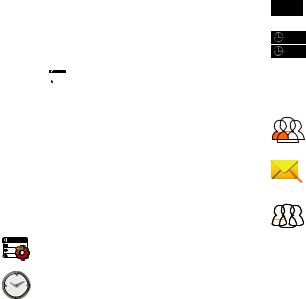
Adding and Deleting Widgets
07:27P
To select which items are displayed or hidden within the Widget
Bar:
zone1
1. From Idle mode, touch the Idle screen or the Widget Bar to
zone2
open it.
2.Touch  .
.
The Widget menu is displayed.
3.Touch the box to place a check mark next to each Widget you want to display.
– or –
Touch the box to remove the check mark from Widgets you
want to hide.
The following table contains a description of each available
Widget.
Widget Manager: allows you to choose which widgets to display on the Widget Bar.
Analogclock:displaysthe currenttimeonananalog clock.
Digital clock: displays the current time on a digital clock.
Dual clock/World clock: displays current time in other user-defined international locations. You can also find out what time it is in another part of the world.
For more information, refer to “World Clock” on page 152.
AT&T Social Net: allows you to access your favorite social networks such as Facebook, Twitter, Myspace, and the News.
Create message: allows you to create new text or picture messages. For more information, refer to
“Creating and Sending Messages” on page 108.
Buddy list: displays the Favorites list. You can use the pull-down Contacts menu to select all Contacts and Groups.
•Drag and drop the Buddy list onto the Idle screen to view the contacts by either Favorites, Groups, or all Contacts. These favorites are listed and can be edited in
Address Book Favorites.
Menu Navigation |
25 |
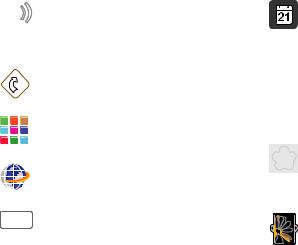
Monday
9 Jan 2009
Voice recognition: allows you to use your voice to dial, look up contacts, launch applications, and navigate phone menus. Follow the on-screen tutorial. For more information, refer to “Voice Recognition” on page 144.
AT&T Navigator: opens AT&T Navigator.
For more information, refer to “AT&T GPS” on page 138.
AppCenter: opens AppCenter.
For more information, refer to “AppCenter” on page 123.
Mobile Web: opens the Mobile Web home page.
For more information, refer to “Mobile Web” on page 154.
Today: displays day of the week and date.
Calendar: allows you to access the Calendar feature.
With the Calendar feature, you can:
•Consult the calendar by month, week, or day.
•Set schedules and note anniversaries.
•Write memos to keep track of your schedule.
•Set an alarm to act as a reminder, if necessary.
•For more information, refer to “Calendar” on page 147.
Favorite URL: allows you to access your most frequently visited internet locations, which you have saved as Favorites, including your account information, chat group, news, sports, weather, and MEdia Net.
Picture: allows you to view the list of photos downloaded from the web server, saved from messages, or taken by the camera. You can then assign the image as the current wallpaper.
For more information, refer to “Using the Camera” on page 92.
26
